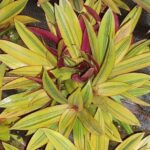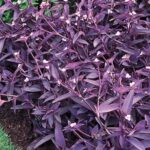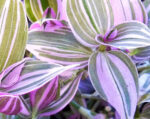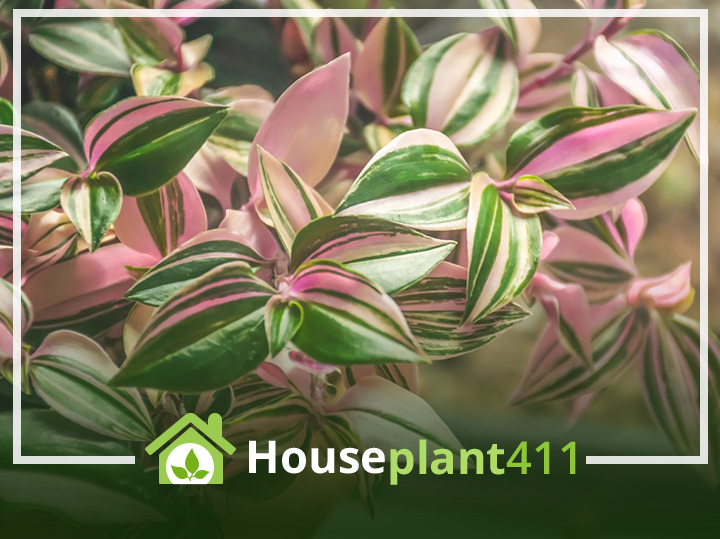About
A Wandering Jew plant, Tradescantia , is a fast growing, easy to care for plant that looks beautiful hanging in front of a window that gets bright, indirect light but no direct sun. Popular nicknames are “Inch Plant” or Spiderwort. Originally found growing as a 1-2ft tall wildflower in Canada and all the way south to Argentina, today a wandering jew plant is both a popular indoor and outdoor plant throughout the world.
Description
The wandering jew plant group is made up of several different varieties. Most have long vines of 2″-4″ oval or heart shaped leaves. Leaf color depends upon the exact type and can be solid green, green with a purple stripe, green with a white or yellow stripe, green with splashes of pink, purple, and cream, or solid purple. The back of the leaf may also be purple. Some wandering jew plants have hairy leaves and some with a silver shine to them. The wandering jew plant produces small flowers in white, pink, purple, or magenta.
Wandering Jew Plant Varieties
The five varieties most commonly used as indoor plants are the Tradescantia zebrina, Tradescantia fluminensis, Tradescantia sillamontana, Tradesantia pallida, and the Tradescantia blossfeldiana.. All types of Wandering Jew plants are easily propagated using stem tip cuttings.
- The Zebrina variety of the Wandering Jew plant has long vines covered in small, stemless leaves about 2” in length. The colorful patterned leaves, green with purple stripes, have a silver shine. The underside of the leaf is a deep purple or magenta color. A Wandering Jew zebrina produces small pink to purple flowers.
- The basic Fluminensis Wandering Jew plant has long stems of small, shiny, oval, dark green leaves with fleshy stems and produces triangular, white flowers. The more popular variegated fluminensis has cream colored or yellow stripes on the leaves.
- The Sillamontana Wandering Jew plant has a different growth pattern and leaf than other members of the tradescantia family. This is not a vining plant. All the leaves, which are covered in white hair, come off a single, thick stem. Magenta flowers develop at the ends of the stems.
- The Palida Wandering Jew plant (Purple Heart Wandering Jew plant) has deep purple leaves with white, purple, or pink flowers.
- The Blossfeldiana Wandering Jew plant has vibrantly colored, fuzzy, green leaves with splashes of pink, purple, and cream and produces clusters of white flowers.




T. Zebrina T. Sitara Gold T. Palida T. Blossfeldiana
Quick Care Tips
Bright light essential for colorful leaves
Reduce water in winter
Repot in the spring if necessary
Avoid temperatures below 45°F ( 7.4°C)
Propagate using stem cuttings
Prune aggressively to keep plant bushy
Wandering Jew Problems
Brown leaf tips: air too dry or spider mites
Limp stems and yellow leaves: plant needs more water
Variegated varieties turn solid green: plant need more light
The sap of a wandering jew plant is slightly toxic to small children, cats, dogs, and other pets.
Read more about common houseplants that are poisonous in my book Don’t Feed Me to Your Cat: A Guide to Poisonous Houseplants.
Plant Care
Light
How much light does a Wandering Jew plant need: Bright indirect light helps the plant produce colorful leaves and flowers. Direct sun causes the color in the leaves to fade.
Water
How to water a Wandering Jew plant: Water well and then allow the top 2″ to 3″ of soil dry out before watering again. If the soil is very dry and the plant is sitting in bright light, the leaves become stunted and lose color. Lack of water can also cause brown and crispy leaves on a Wandering Jew plant. This usually problem affects to older growth first. Over watering is more serious, resulting in root rot.
Fertilizer
Feed monthly when a Wandering Jew plant is producing new growth with a water-soluble houseplant food diluted to 1/2 the recommended strength. How to fertilize a Wandering Jew plant: Using a plant food high in nitrogen helps the plant produce more colorful leaves. Over-fertilizing causes the bright colors in the leaves to fade.
Temperature
Best temperature for a Wandering Jew plant: Try to maintain temperatures between 60°- 80°F (15.6°- 26.7°C).
Humidity
Does a Wandering Jew plant need high humidity: Average to high household humidity is best. If the air is too dry, the leaves of a Wandering Jew plant turn brown. Place a Wandering Jew plant on a tray of wet pebbles to increase the humidity; be sure the plant is sitting on the pebbles and not in the water.
Flowering
Does a Wandering Jew plant flower: In ideal growing conditions, the plant produces small white, pink, or purple flowers.
Pests
Wandering Jew plant pests: Although these plants are fairly pest resistant, aphids, scale, and mealy bugs can be a problem. See pictures of these plant pests and learn how to get rid of them in Glossary of the website.
Diseases
Wandering Jew plant diseases: The high humidity that helps the plant grow better also encourages fungal and bacterial idiseases
Soil
Best soil to use for a Wandering Jew plant: Use a well- aerated soil that drains quickly. If the soil seems heavy and clay-like, add some peat moss and perlite.
Pot Size
What size pot for a Wandering Jew plant: This is a fast growing plant so check the root-ball frequently to see if a larger pot is needed. Repot, when necessary, in the spring. Use the next size pot, nothing larger, and be sure there are drip holes in the bottom.
Pruning
How to prune a Wandering jew plant: When the stems get very long and leggy as the plant matures, don’t hesitate to aggressively prune the plant. When pruning, make the cut above a leaf node (the place where a leaf is attached to the stem). It may take a while for the trimmed stems to bush out , so be patient. You can use the stem clippings to propagate new plants.
Propagation
How to propagate a Wandering Jew plant: Very easy to do, take stem cuttings in the spring, summer,or fall. You can read more about how to propagate a plant using plant cuttings in the Glossary of the website.
Poisonous Plant Info
A Wandering Jew plant is slightly poisonous with a Level #1 toxicity. It is toxic to dogs, cats, and small children. The sap of the plant is caustic and may cause skin irritations or a rash. It is, however, considered safe to put into bird or reptile enclosures.
FAQ
If a Wandering Jew plant gets a few hours of direct sun every day, the color in the leaves fades. I’d recommend moving your plant to a different area where it will get bright indirect light.
You probably waited a little too long before pruning your Wandering Jew plant so that’s why it’s still not doing well. Unlike most houseplants, Wandering Jew plants take a long time before starting to produce new leaves. Place your plant in bright indirect light and be patient. You can always use some of the Stem Cuttings to start some new plants.
You are killing your Wandering Jew plant with kindness. A Wandering Jew plant gets brown leaves and mushy stems when it is over-watered and over-fed. This plant needs water when the top few inches of soil are dry. Over- feeding is worse than no food at all. Fertilize monthly with a water soluble plant food diluted to 1/2 the recommended strength. Feed only when the plant is producing new leaves. For now, cut off all of the brown leaves and soggy stems and replace the soggy soil with new, fresh, well-aerated soil. Place your Wandering Jew plant in a warm bright area, water carefully, and do not fertilize for at least two months.

